Dementia Care: Case Study of Mrs. Grey's Nursing Home Experience
VerifiedAdded on 2023/01/09
|7
|2030
|99
Case Study
AI Summary
This case study examines the complex care of Mrs. Grey, an 87-year-old widow admitted to a nursing home for dementia treatment. The assignment utilizes the Gibbs Reflective Principle to analyze the management process, exploring the ethical dilemmas faced by the nursing staff, particularly regarding Mrs. Grey's hygiene and wandering. The case study details the initial attempts to support Mrs. Grey's daily activities, the challenges in maintaining her hygiene, and the use of restraints, leading to her frustration and aggressive behavior. It reflects on the feelings of the staff and family, evaluates the effectiveness of the treatment methods, and analyzes the importance of communication and patient collaboration. The conclusion emphasizes the need for a patient-centered approach, including interviews and the development of individualized care plans to improve patient acceptance and satisfaction. The case study highlights the importance of effective communication and training for care providers to handle challenging situations, ultimately aiming for a more empathetic and effective approach to dementia care.
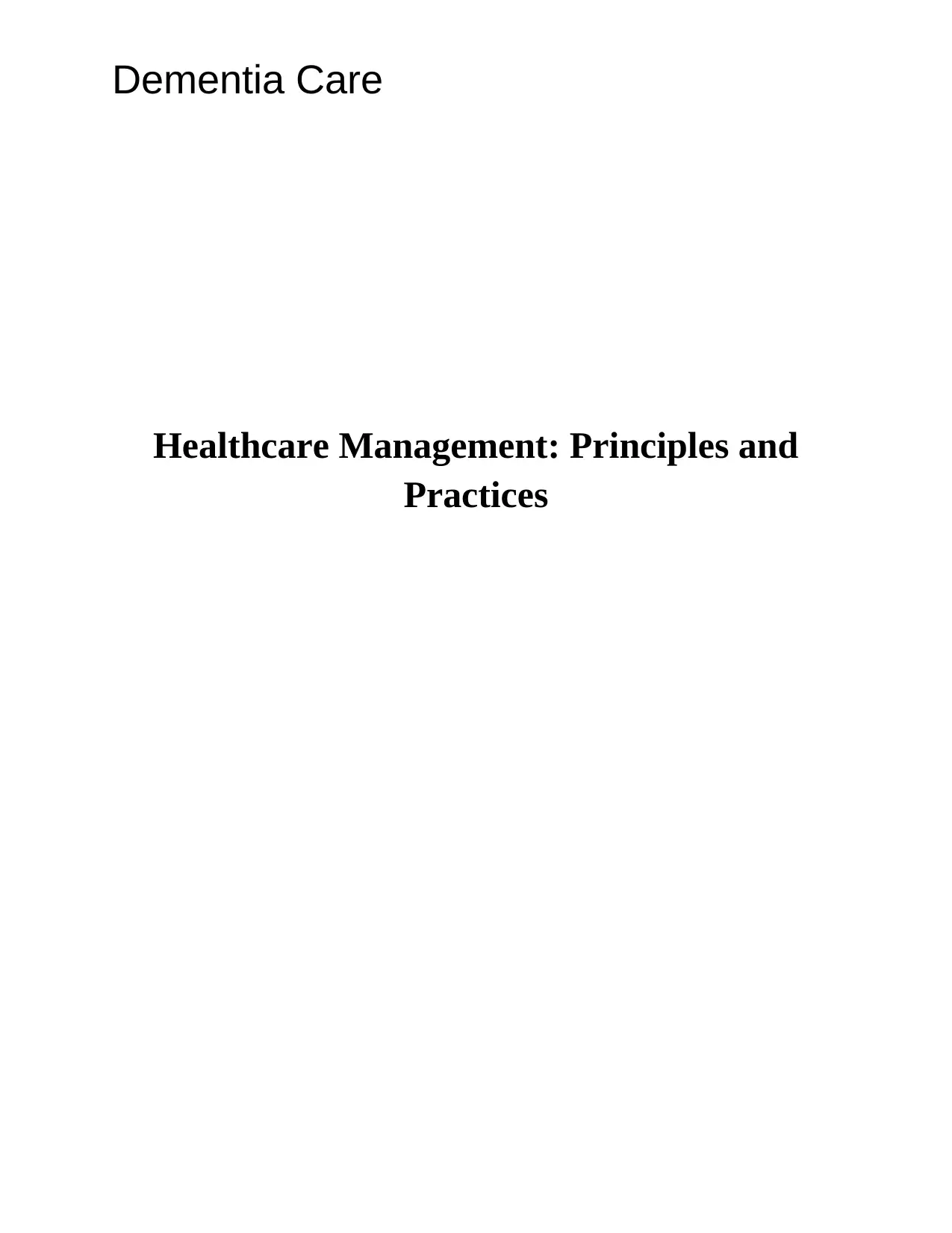
Dementia Care
Healthcare Management: Principles and
Practices
Healthcare Management: Principles and
Practices
Paraphrase This Document
Need a fresh take? Get an instant paraphrase of this document with our AI Paraphraser
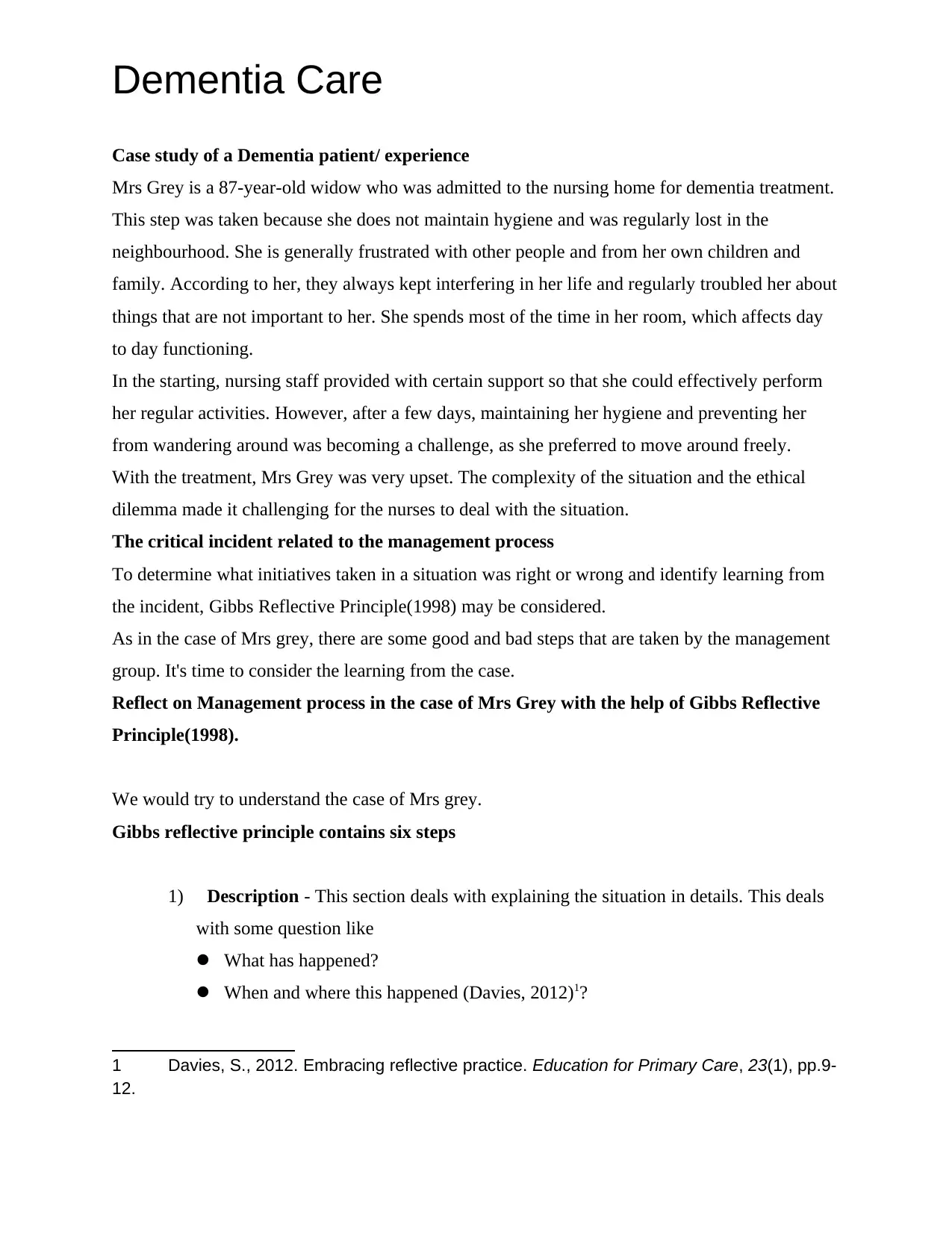
Dementia Care
Case study of a Dementia patient/ experience
Mrs Grey is a 87-year-old widow who was admitted to the nursing home for dementia treatment.
This step was taken because she does not maintain hygiene and was regularly lost in the
neighbourhood. She is generally frustrated with other people and from her own children and
family. According to her, they always kept interfering in her life and regularly troubled her about
things that are not important to her. She spends most of the time in her room, which affects day
to day functioning.
In the starting, nursing staff provided with certain support so that she could effectively perform
her regular activities. However, after a few days, maintaining her hygiene and preventing her
from wandering around was becoming a challenge, as she preferred to move around freely.
With the treatment, Mrs Grey was very upset. The complexity of the situation and the ethical
dilemma made it challenging for the nurses to deal with the situation.
The critical incident related to the management process
To determine what initiatives taken in a situation was right or wrong and identify learning from
the incident, Gibbs Reflective Principle(1998) may be considered.
As in the case of Mrs grey, there are some good and bad steps that are taken by the management
group. It's time to consider the learning from the case.
Reflect on Management process in the case of Mrs Grey with the help of Gibbs Reflective
Principle(1998).
We would try to understand the case of Mrs grey.
Gibbs reflective principle contains six steps
1) Description - This section deals with explaining the situation in details. This deals
with some question like
What has happened?
When and where this happened (Davies, 2012)1?
1 Davies, S., 2012. Embracing reflective practice. Education for Primary Care, 23(1), pp.9-
12.
Case study of a Dementia patient/ experience
Mrs Grey is a 87-year-old widow who was admitted to the nursing home for dementia treatment.
This step was taken because she does not maintain hygiene and was regularly lost in the
neighbourhood. She is generally frustrated with other people and from her own children and
family. According to her, they always kept interfering in her life and regularly troubled her about
things that are not important to her. She spends most of the time in her room, which affects day
to day functioning.
In the starting, nursing staff provided with certain support so that she could effectively perform
her regular activities. However, after a few days, maintaining her hygiene and preventing her
from wandering around was becoming a challenge, as she preferred to move around freely.
With the treatment, Mrs Grey was very upset. The complexity of the situation and the ethical
dilemma made it challenging for the nurses to deal with the situation.
The critical incident related to the management process
To determine what initiatives taken in a situation was right or wrong and identify learning from
the incident, Gibbs Reflective Principle(1998) may be considered.
As in the case of Mrs grey, there are some good and bad steps that are taken by the management
group. It's time to consider the learning from the case.
Reflect on Management process in the case of Mrs Grey with the help of Gibbs Reflective
Principle(1998).
We would try to understand the case of Mrs grey.
Gibbs reflective principle contains six steps
1) Description - This section deals with explaining the situation in details. This deals
with some question like
What has happened?
When and where this happened (Davies, 2012)1?
1 Davies, S., 2012. Embracing reflective practice. Education for Primary Care, 23(1), pp.9-
12.
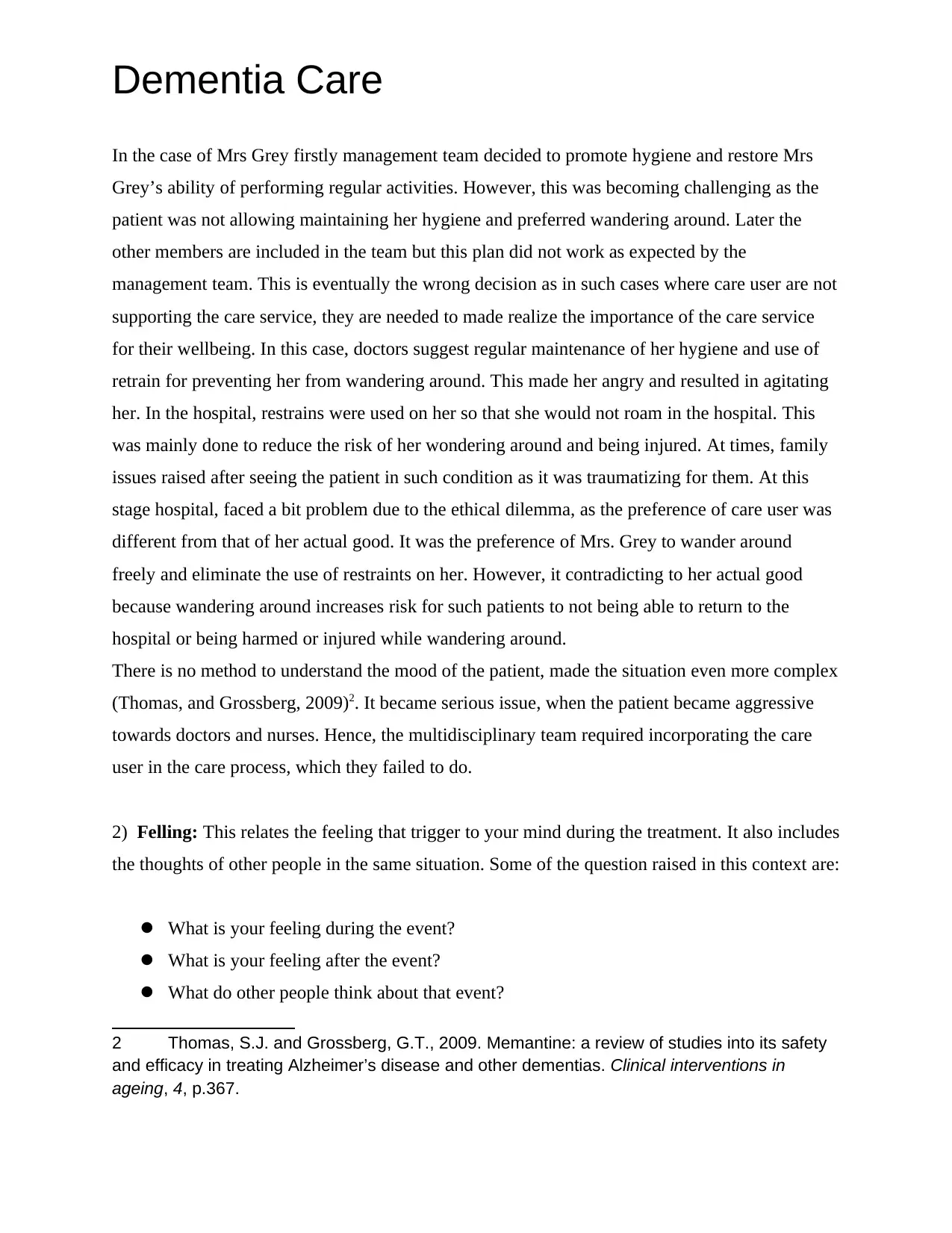
Dementia Care
In the case of Mrs Grey firstly management team decided to promote hygiene and restore Mrs
Grey’s ability of performing regular activities. However, this was becoming challenging as the
patient was not allowing maintaining her hygiene and preferred wandering around. Later the
other members are included in the team but this plan did not work as expected by the
management team. This is eventually the wrong decision as in such cases where care user are not
supporting the care service, they are needed to made realize the importance of the care service
for their wellbeing. In this case, doctors suggest regular maintenance of her hygiene and use of
retrain for preventing her from wandering around. This made her angry and resulted in agitating
her. In the hospital, restrains were used on her so that she would not roam in the hospital. This
was mainly done to reduce the risk of her wondering around and being injured. At times, family
issues raised after seeing the patient in such condition as it was traumatizing for them. At this
stage hospital, faced a bit problem due to the ethical dilemma, as the preference of care user was
different from that of her actual good. It was the preference of Mrs. Grey to wander around
freely and eliminate the use of restraints on her. However, it contradicting to her actual good
because wandering around increases risk for such patients to not being able to return to the
hospital or being harmed or injured while wandering around.
There is no method to understand the mood of the patient, made the situation even more complex
(Thomas, and Grossberg, 2009)2. It became serious issue, when the patient became aggressive
towards doctors and nurses. Hence, the multidisciplinary team required incorporating the care
user in the care process, which they failed to do.
2) Felling: This relates the feeling that trigger to your mind during the treatment. It also includes
the thoughts of other people in the same situation. Some of the question raised in this context are:
What is your feeling during the event?
What is your feeling after the event?
What do other people think about that event?
2 Thomas, S.J. and Grossberg, G.T., 2009. Memantine: a review of studies into its safety
and efficacy in treating Alzheimer’s disease and other dementias. Clinical interventions in
ageing, 4, p.367.
In the case of Mrs Grey firstly management team decided to promote hygiene and restore Mrs
Grey’s ability of performing regular activities. However, this was becoming challenging as the
patient was not allowing maintaining her hygiene and preferred wandering around. Later the
other members are included in the team but this plan did not work as expected by the
management team. This is eventually the wrong decision as in such cases where care user are not
supporting the care service, they are needed to made realize the importance of the care service
for their wellbeing. In this case, doctors suggest regular maintenance of her hygiene and use of
retrain for preventing her from wandering around. This made her angry and resulted in agitating
her. In the hospital, restrains were used on her so that she would not roam in the hospital. This
was mainly done to reduce the risk of her wondering around and being injured. At times, family
issues raised after seeing the patient in such condition as it was traumatizing for them. At this
stage hospital, faced a bit problem due to the ethical dilemma, as the preference of care user was
different from that of her actual good. It was the preference of Mrs. Grey to wander around
freely and eliminate the use of restraints on her. However, it contradicting to her actual good
because wandering around increases risk for such patients to not being able to return to the
hospital or being harmed or injured while wandering around.
There is no method to understand the mood of the patient, made the situation even more complex
(Thomas, and Grossberg, 2009)2. It became serious issue, when the patient became aggressive
towards doctors and nurses. Hence, the multidisciplinary team required incorporating the care
user in the care process, which they failed to do.
2) Felling: This relates the feeling that trigger to your mind during the treatment. It also includes
the thoughts of other people in the same situation. Some of the question raised in this context are:
What is your feeling during the event?
What is your feeling after the event?
What do other people think about that event?
2 Thomas, S.J. and Grossberg, G.T., 2009. Memantine: a review of studies into its safety
and efficacy in treating Alzheimer’s disease and other dementias. Clinical interventions in
ageing, 4, p.367.
⊘ This is a preview!⊘
Do you want full access?
Subscribe today to unlock all pages.

Trusted by 1+ million students worldwide
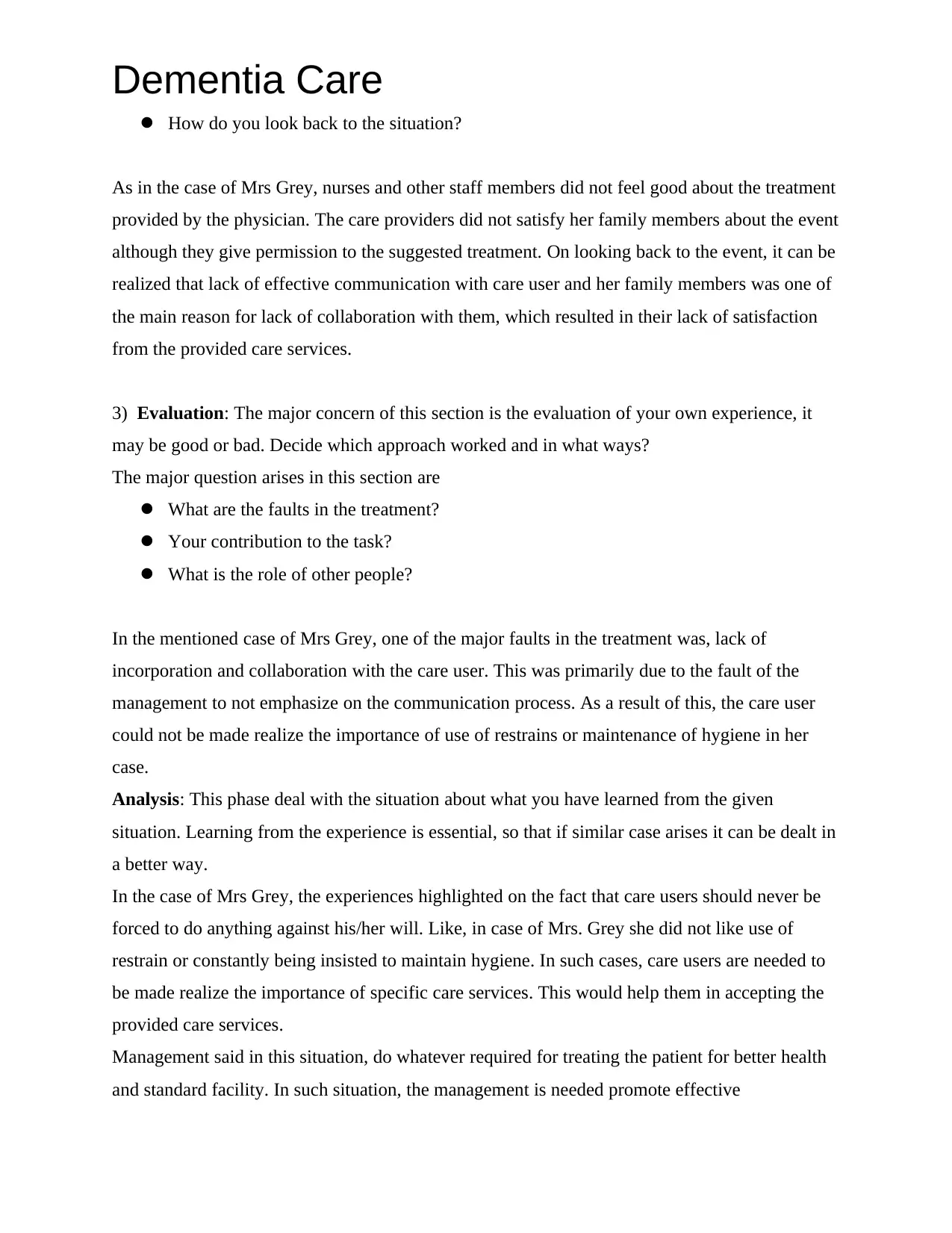
Dementia Care
How do you look back to the situation?
As in the case of Mrs Grey, nurses and other staff members did not feel good about the treatment
provided by the physician. The care providers did not satisfy her family members about the event
although they give permission to the suggested treatment. On looking back to the event, it can be
realized that lack of effective communication with care user and her family members was one of
the main reason for lack of collaboration with them, which resulted in their lack of satisfaction
from the provided care services.
3) Evaluation: The major concern of this section is the evaluation of your own experience, it
may be good or bad. Decide which approach worked and in what ways?
The major question arises in this section are
What are the faults in the treatment?
Your contribution to the task?
What is the role of other people?
In the mentioned case of Mrs Grey, one of the major faults in the treatment was, lack of
incorporation and collaboration with the care user. This was primarily due to the fault of the
management to not emphasize on the communication process. As a result of this, the care user
could not be made realize the importance of use of restrains or maintenance of hygiene in her
case.
Analysis: This phase deal with the situation about what you have learned from the given
situation. Learning from the experience is essential, so that if similar case arises it can be dealt in
a better way.
In the case of Mrs Grey, the experiences highlighted on the fact that care users should never be
forced to do anything against his/her will. Like, in case of Mrs. Grey she did not like use of
restrain or constantly being insisted to maintain hygiene. In such cases, care users are needed to
be made realize the importance of specific care services. This would help them in accepting the
provided care services.
Management said in this situation, do whatever required for treating the patient for better health
and standard facility. In such situation, the management is needed promote effective
How do you look back to the situation?
As in the case of Mrs Grey, nurses and other staff members did not feel good about the treatment
provided by the physician. The care providers did not satisfy her family members about the event
although they give permission to the suggested treatment. On looking back to the event, it can be
realized that lack of effective communication with care user and her family members was one of
the main reason for lack of collaboration with them, which resulted in their lack of satisfaction
from the provided care services.
3) Evaluation: The major concern of this section is the evaluation of your own experience, it
may be good or bad. Decide which approach worked and in what ways?
The major question arises in this section are
What are the faults in the treatment?
Your contribution to the task?
What is the role of other people?
In the mentioned case of Mrs Grey, one of the major faults in the treatment was, lack of
incorporation and collaboration with the care user. This was primarily due to the fault of the
management to not emphasize on the communication process. As a result of this, the care user
could not be made realize the importance of use of restrains or maintenance of hygiene in her
case.
Analysis: This phase deal with the situation about what you have learned from the given
situation. Learning from the experience is essential, so that if similar case arises it can be dealt in
a better way.
In the case of Mrs Grey, the experiences highlighted on the fact that care users should never be
forced to do anything against his/her will. Like, in case of Mrs. Grey she did not like use of
restrain or constantly being insisted to maintain hygiene. In such cases, care users are needed to
be made realize the importance of specific care services. This would help them in accepting the
provided care services.
Management said in this situation, do whatever required for treating the patient for better health
and standard facility. In such situation, the management is needed promote effective
Paraphrase This Document
Need a fresh take? Get an instant paraphrase of this document with our AI Paraphraser
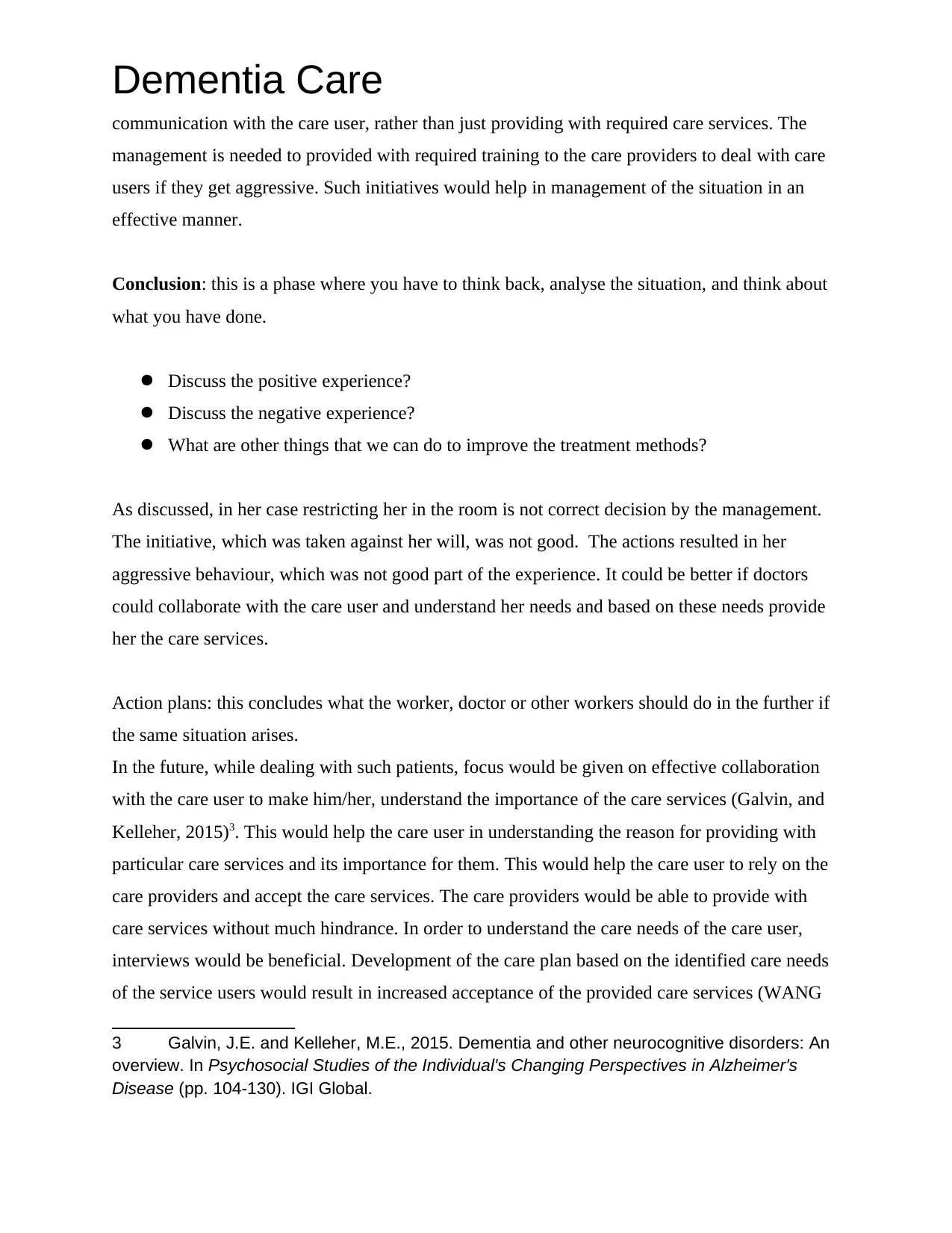
Dementia Care
communication with the care user, rather than just providing with required care services. The
management is needed to provided with required training to the care providers to deal with care
users if they get aggressive. Such initiatives would help in management of the situation in an
effective manner.
Conclusion: this is a phase where you have to think back, analyse the situation, and think about
what you have done.
Discuss the positive experience?
Discuss the negative experience?
What are other things that we can do to improve the treatment methods?
As discussed, in her case restricting her in the room is not correct decision by the management.
The initiative, which was taken against her will, was not good. The actions resulted in her
aggressive behaviour, which was not good part of the experience. It could be better if doctors
could collaborate with the care user and understand her needs and based on these needs provide
her the care services.
Action plans: this concludes what the worker, doctor or other workers should do in the further if
the same situation arises.
In the future, while dealing with such patients, focus would be given on effective collaboration
with the care user to make him/her, understand the importance of the care services (Galvin, and
Kelleher, 2015)3. This would help the care user in understanding the reason for providing with
particular care services and its importance for them. This would help the care user to rely on the
care providers and accept the care services. The care providers would be able to provide with
care services without much hindrance. In order to understand the care needs of the care user,
interviews would be beneficial. Development of the care plan based on the identified care needs
of the service users would result in increased acceptance of the provided care services (WANG
3 Galvin, J.E. and Kelleher, M.E., 2015. Dementia and other neurocognitive disorders: An
overview. In Psychosocial Studies of the Individual's Changing Perspectives in Alzheimer's
Disease (pp. 104-130). IGI Global.
communication with the care user, rather than just providing with required care services. The
management is needed to provided with required training to the care providers to deal with care
users if they get aggressive. Such initiatives would help in management of the situation in an
effective manner.
Conclusion: this is a phase where you have to think back, analyse the situation, and think about
what you have done.
Discuss the positive experience?
Discuss the negative experience?
What are other things that we can do to improve the treatment methods?
As discussed, in her case restricting her in the room is not correct decision by the management.
The initiative, which was taken against her will, was not good. The actions resulted in her
aggressive behaviour, which was not good part of the experience. It could be better if doctors
could collaborate with the care user and understand her needs and based on these needs provide
her the care services.
Action plans: this concludes what the worker, doctor or other workers should do in the further if
the same situation arises.
In the future, while dealing with such patients, focus would be given on effective collaboration
with the care user to make him/her, understand the importance of the care services (Galvin, and
Kelleher, 2015)3. This would help the care user in understanding the reason for providing with
particular care services and its importance for them. This would help the care user to rely on the
care providers and accept the care services. The care providers would be able to provide with
care services without much hindrance. In order to understand the care needs of the care user,
interviews would be beneficial. Development of the care plan based on the identified care needs
of the service users would result in increased acceptance of the provided care services (WANG
3 Galvin, J.E. and Kelleher, M.E., 2015. Dementia and other neurocognitive disorders: An
overview. In Psychosocial Studies of the Individual's Changing Perspectives in Alzheimer's
Disease (pp. 104-130). IGI Global.
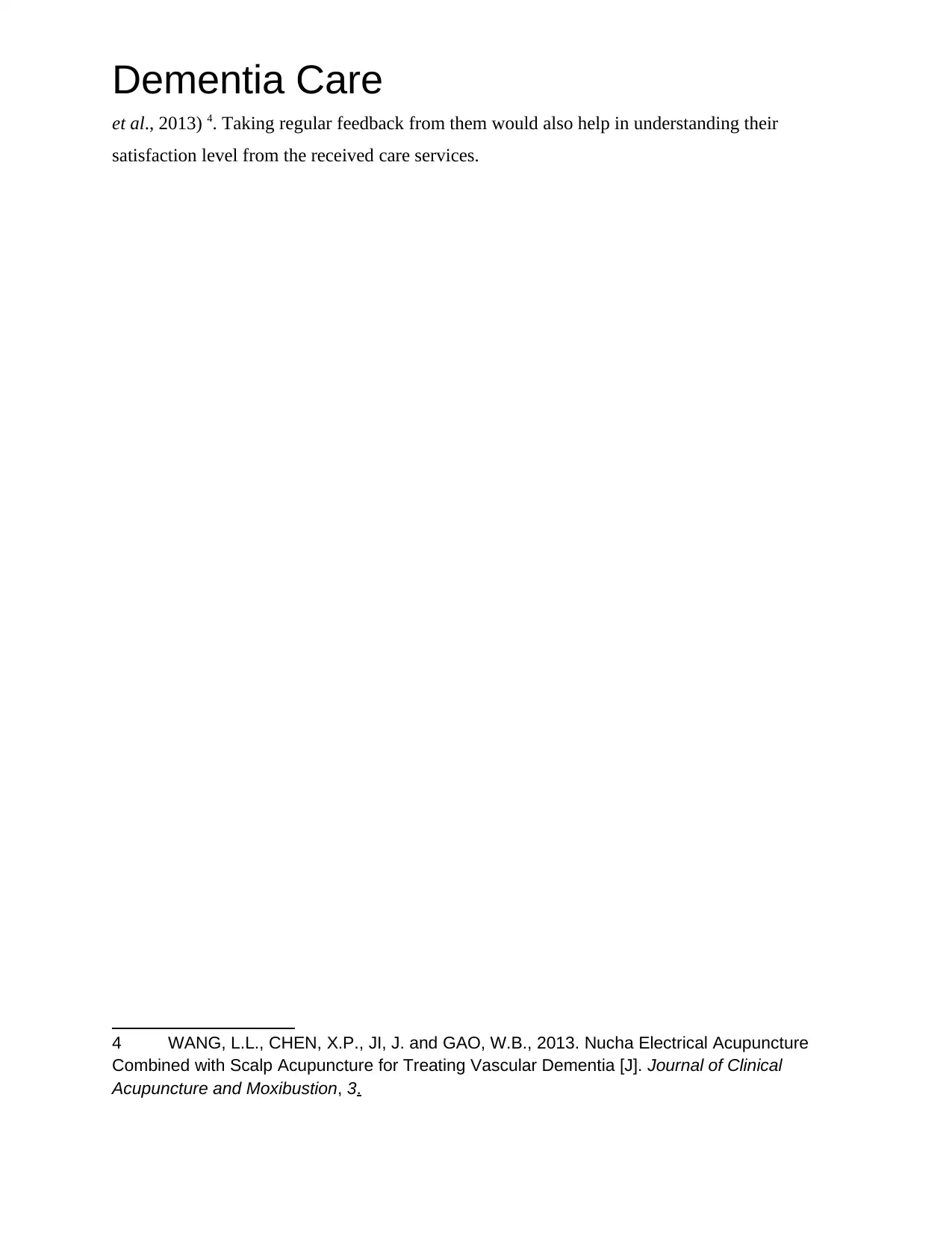
Dementia Care
et al., 2013) 4. Taking regular feedback from them would also help in understanding their
satisfaction level from the received care services.
4 WANG, L.L., CHEN, X.P., JI, J. and GAO, W.B., 2013. Nucha Electrical Acupuncture
Combined with Scalp Acupuncture for Treating Vascular Dementia [J]. Journal of Clinical
Acupuncture and Moxibustion, 3.
et al., 2013) 4. Taking regular feedback from them would also help in understanding their
satisfaction level from the received care services.
4 WANG, L.L., CHEN, X.P., JI, J. and GAO, W.B., 2013. Nucha Electrical Acupuncture
Combined with Scalp Acupuncture for Treating Vascular Dementia [J]. Journal of Clinical
Acupuncture and Moxibustion, 3.
⊘ This is a preview!⊘
Do you want full access?
Subscribe today to unlock all pages.

Trusted by 1+ million students worldwide
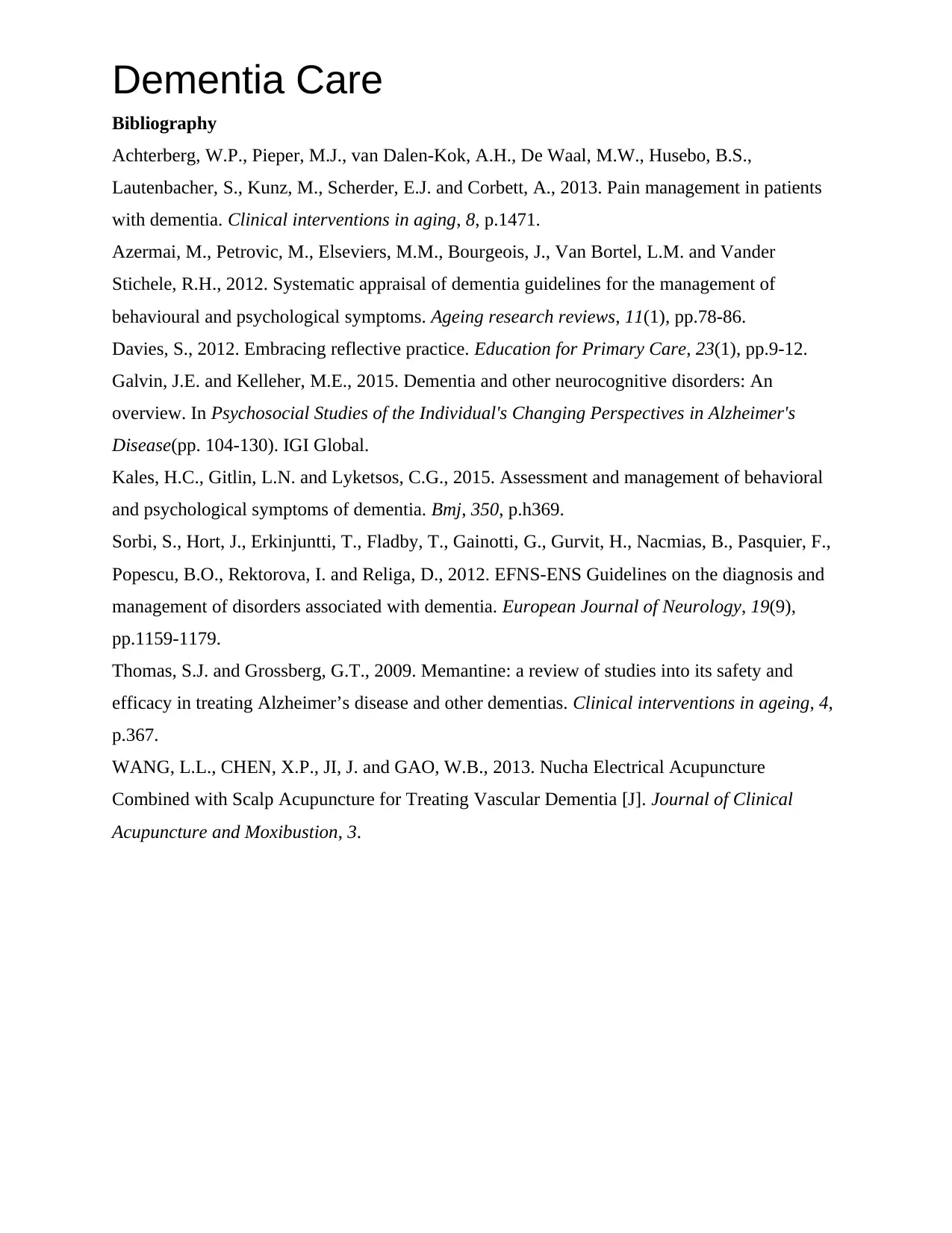
Dementia Care
Bibliography
Achterberg, W.P., Pieper, M.J., van Dalen-Kok, A.H., De Waal, M.W., Husebo, B.S.,
Lautenbacher, S., Kunz, M., Scherder, E.J. and Corbett, A., 2013. Pain management in patients
with dementia. Clinical interventions in aging, 8, p.1471.
Azermai, M., Petrovic, M., Elseviers, M.M., Bourgeois, J., Van Bortel, L.M. and Vander
Stichele, R.H., 2012. Systematic appraisal of dementia guidelines for the management of
behavioural and psychological symptoms. Ageing research reviews, 11(1), pp.78-86.
Davies, S., 2012. Embracing reflective practice. Education for Primary Care, 23(1), pp.9-12.
Galvin, J.E. and Kelleher, M.E., 2015. Dementia and other neurocognitive disorders: An
overview. In Psychosocial Studies of the Individual's Changing Perspectives in Alzheimer's
Disease(pp. 104-130). IGI Global.
Kales, H.C., Gitlin, L.N. and Lyketsos, C.G., 2015. Assessment and management of behavioral
and psychological symptoms of dementia. Bmj, 350, p.h369.
Sorbi, S., Hort, J., Erkinjuntti, T., Fladby, T., Gainotti, G., Gurvit, H., Nacmias, B., Pasquier, F.,
Popescu, B.O., Rektorova, I. and Religa, D., 2012. EFNS‐ENS Guidelines on the diagnosis and
management of disorders associated with dementia. European Journal of Neurology, 19(9),
pp.1159-1179.
Thomas, S.J. and Grossberg, G.T., 2009. Memantine: a review of studies into its safety and
efficacy in treating Alzheimer’s disease and other dementias. Clinical interventions in ageing, 4,
p.367.
WANG, L.L., CHEN, X.P., JI, J. and GAO, W.B., 2013. Nucha Electrical Acupuncture
Combined with Scalp Acupuncture for Treating Vascular Dementia [J]. Journal of Clinical
Acupuncture and Moxibustion, 3.
Bibliography
Achterberg, W.P., Pieper, M.J., van Dalen-Kok, A.H., De Waal, M.W., Husebo, B.S.,
Lautenbacher, S., Kunz, M., Scherder, E.J. and Corbett, A., 2013. Pain management in patients
with dementia. Clinical interventions in aging, 8, p.1471.
Azermai, M., Petrovic, M., Elseviers, M.M., Bourgeois, J., Van Bortel, L.M. and Vander
Stichele, R.H., 2012. Systematic appraisal of dementia guidelines for the management of
behavioural and psychological symptoms. Ageing research reviews, 11(1), pp.78-86.
Davies, S., 2012. Embracing reflective practice. Education for Primary Care, 23(1), pp.9-12.
Galvin, J.E. and Kelleher, M.E., 2015. Dementia and other neurocognitive disorders: An
overview. In Psychosocial Studies of the Individual's Changing Perspectives in Alzheimer's
Disease(pp. 104-130). IGI Global.
Kales, H.C., Gitlin, L.N. and Lyketsos, C.G., 2015. Assessment and management of behavioral
and psychological symptoms of dementia. Bmj, 350, p.h369.
Sorbi, S., Hort, J., Erkinjuntti, T., Fladby, T., Gainotti, G., Gurvit, H., Nacmias, B., Pasquier, F.,
Popescu, B.O., Rektorova, I. and Religa, D., 2012. EFNS‐ENS Guidelines on the diagnosis and
management of disorders associated with dementia. European Journal of Neurology, 19(9),
pp.1159-1179.
Thomas, S.J. and Grossberg, G.T., 2009. Memantine: a review of studies into its safety and
efficacy in treating Alzheimer’s disease and other dementias. Clinical interventions in ageing, 4,
p.367.
WANG, L.L., CHEN, X.P., JI, J. and GAO, W.B., 2013. Nucha Electrical Acupuncture
Combined with Scalp Acupuncture for Treating Vascular Dementia [J]. Journal of Clinical
Acupuncture and Moxibustion, 3.
1 out of 7
Related Documents
Your All-in-One AI-Powered Toolkit for Academic Success.
+13062052269
info@desklib.com
Available 24*7 on WhatsApp / Email
![[object Object]](/_next/static/media/star-bottom.7253800d.svg)
Unlock your academic potential
Copyright © 2020–2025 A2Z Services. All Rights Reserved. Developed and managed by ZUCOL.




